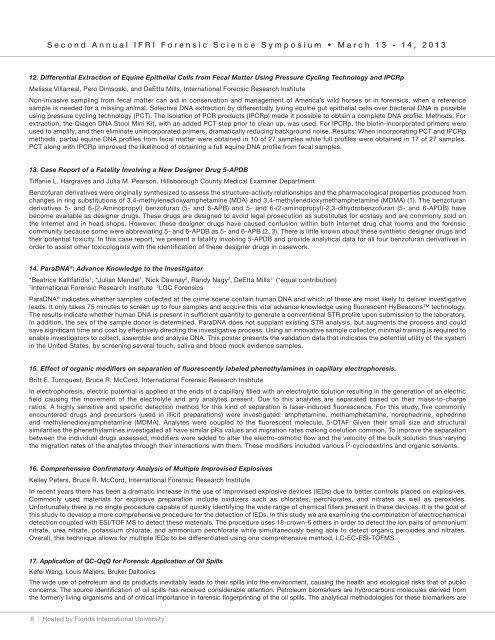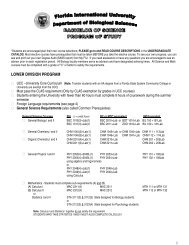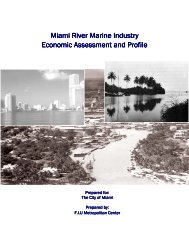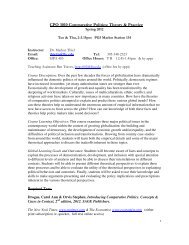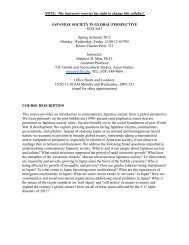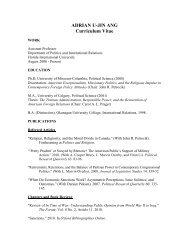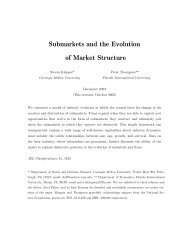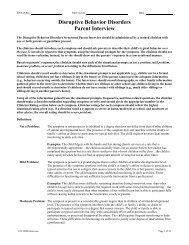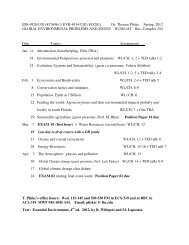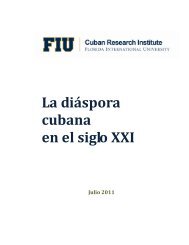Second Annual IFRI Forensic Science Symposium - College of Arts ...
Second Annual IFRI Forensic Science Symposium - College of Arts ...
Second Annual IFRI Forensic Science Symposium - College of Arts ...
Create successful ePaper yourself
Turn your PDF publications into a flip-book with our unique Google optimized e-Paper software.
<strong>Second</strong> <strong>Annual</strong> <strong>IFRI</strong> <strong>Forensic</strong> <strong>Science</strong> <strong>Symposium</strong> • March 13 - 14, 2013<br />
12. Differential Extraction <strong>of</strong> Equine Epithelial Cells from Fecal Matter Using Pressure Cycling Technology and IPCRp<br />
Melissa Villarreal, Pero Dimsoski, and DeEtta Mills, International <strong>Forensic</strong> Research Institute<br />
Non-invasive sampling from fecal matter can aid in conservation and management <strong>of</strong> America’s wild horses or in forensics, when a reference<br />
sample is needed for a missing animal. Selective DNA extraction by differentially lysing equine gut epithelial cells over bacterial DNA is possible<br />
using pressure cycling technology (PCT). The Isolation <strong>of</strong> PCR products (IPCRp) made it possible to obtain a complete DNA pr<strong>of</strong>ile. Methods: For<br />
extraction, the Qiagen DNA Stool Mini Kit, with an added PCT step prior to clean up, was used. For IPCRp, the biotin-incorporated primers were<br />
used to amplify, and then eliminate unincorporated primers, dramatically reducing background noise. Results: When incorporating PCT and IPCRp<br />
methods, partial equine DNA pr<strong>of</strong>iles from fecal matter were obtained in 10 <strong>of</strong> 27 samples while full pr<strong>of</strong>iles were obtained in 17 <strong>of</strong> 27 samples.<br />
PCT along with IPCRp improved the likelihood <strong>of</strong> obtaining a full equine DNA pr<strong>of</strong>ile from fecal samples.<br />
13. Case Report <strong>of</strong> a Fatality Involving a New Designer Drug 5-APDB<br />
Tiffanie L. Hargraves and Julia M. Pearson, Hillsborough County Medical Examiner Department<br />
Benz<strong>of</strong>uran derivatives were originally synthesized to assess the structure-activity relationships and the pharmacological properties produced from<br />
changes in ring substitutions <strong>of</strong> 3,4-methylenedioxyamphetamine (MDA) and 3,4-methylenedioxymethamphetamine (MDMA) (1). The benz<strong>of</strong>uran<br />
derivatives 5- and 6-(2-Aminopropyl) benz<strong>of</strong>uran (5- and 6-APB) and 5- and 6-(2-aminopropyl)-2,3-dihydrobenz<strong>of</strong>uran (5- and 6-APDB) have<br />
become available as designer drugs. These drugs are designed to avoid legal prosecution as substitutes for ecstasy and are commonly sold on<br />
the Internet and in head shops. However, these designer drugs have caused confusion within both Internet drug chat rooms and the forensic<br />
community because some were abbreviating 5- and 6-APDB as 5- and 6-APB (2, 3). There is little known about these synthetic designer drugs and<br />
their potential toxicity. In this case report, we present a fatality involving 5-APDB and provide analytical data for all four benz<strong>of</strong>uran derivatives in<br />
order to assist other toxicologists with the identification <strong>of</strong> these designer drugs in casework.<br />
14. ParaDNA ® : Advance Knowledge to the Investigator<br />
*Beatrice Kallifatidis 1 , *Julian Mendel 1 , Nick Dawnay 2 , Randy Nagy 2 , DeEtta Mills 1 (*equal contribution)<br />
1 International <strong>Forensic</strong> Research Institute 2 LGC <strong>Forensic</strong>s<br />
ParaDNA ® indicates whether samples collected at the crime scene contain human DNA and which <strong>of</strong> these are most likely to deliver investigative<br />
leads. It only takes 75 minutes to screen up to four samples and acquire this vital advance knowledge using fluorescent HyBeacons technology.<br />
The results indicate whether human DNA is present in sufficient quantity to generate a conventional STR pr<strong>of</strong>ile upon submission to the laboratory.<br />
In addition, the sex <strong>of</strong> the sample donor is determined. ParaDNA does not supplant existing STR analysis, but augments the process and could<br />
save significant time and cost by effectively directing the investigative process. Using an innovative sample collector, minimal training is required to<br />
enable investigators to collect, assemble and analyse DNA. This poster presents the validation data that indicates the potential utility <strong>of</strong> the system<br />
in the United States, by screening several touch, saliva and blood mock evidence samples.<br />
15. Effect <strong>of</strong> organic modifiers on separation <strong>of</strong> fluorescently labeled phenethylamines in capillary electrophoresis.<br />
Britt E. Turnquest, Bruce R. McCord, International <strong>Forensic</strong> Research Institute<br />
In electrophoresis, electric potential is applied at the ends <strong>of</strong> a capillary filled with an electrolytic solution resulting in the generation <strong>of</strong> an electric<br />
field causing the movement <strong>of</strong> the electrolyte and any analytes present. Due to this analytes are separated based on their mass-to-charge<br />
ratios. A highly sensitive and specific detection method for this kind <strong>of</strong> separation is laser-induced fluorescence. For this study, five commonly<br />
encountered drugs and precursors (used in illicit preparations) were investigated: amphetamine, methamphetamine, norephedrine, ephedrine<br />
and methylenedioxyamphetamine (MDMA). Analytes were coupled to the fluorescent molecule, 5-DTAF. Given their small size and structural<br />
similarities the phenethylamines investigated all have similar pKa values and migration rates making coelution common. To improve the separation<br />
between the individual drugs assessed, modifiers were added to alter the electro-osmotic flow and the velocity <strong>of</strong> the bulk solution thus varying<br />
the migration rates <strong>of</strong> the analytes through their interactions with them. These modifiers included various β-cyclodextrins and organic solvents.<br />
16. Comprehensive Confirmatory Analysis <strong>of</strong> Multiple Improvised Explosives<br />
Kelley Peters, Bruce R. McCord, International <strong>Forensic</strong> Research Institute<br />
In recent years there has been a dramatic increase in the use <strong>of</strong> improvised explosive devices (IEDs) due to better controls placed on explosives.<br />
Commonly used materials for explosive preparation include oxidizers such as chlorates, perchlorates, and nitrates as well as peroxides.<br />
Unfortunately there is no single procedure capable <strong>of</strong> quickly identifying the wide range <strong>of</strong> chemical fillers present in these devices. It is the goal <strong>of</strong><br />
this study to develop a more comprehensive procedure for the detection <strong>of</strong> IEDs. In this study we are examining the combination <strong>of</strong> electrochemical<br />
detection coupled with ESI/TOF MS to detect these materials. The procedure uses 18-crown-6 ethers in order to detect the ion pairs <strong>of</strong> ammonium<br />
nitrate, urea nitrate, potassium chlorate, and ammonium perchlorate while simultaneously being able to detect organic peroxides and nitrates.<br />
Overall, this technique allows for multiple IEDs to be differentiated using one comprehensive method, LC-EC-ESI-TOFMS.<br />
17. Application <strong>of</strong> GC-QqQ for <strong>Forensic</strong> Application <strong>of</strong> Oil Spills<br />
Kefei Wang, Louis Maljers, Bruker Daltonics<br />
The wide use <strong>of</strong> petroleum and its products inevitably leads to their spills into the environment, causing the health and ecological risks that <strong>of</strong> public<br />
concerns. The source identification <strong>of</strong> oil spills has received considerable attention. Petroleum biomarkers are hydrocarbons molecules derived from<br />
the formerly living organisms and <strong>of</strong> critical importance in forensic fingerprinting <strong>of</strong> the oil spills. The analytical methodologies for these biomarkers are<br />
8 | Hosted by Florida International University


